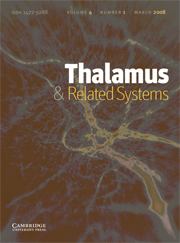Article contents
Neurofilament subunit protein abnormalities in the thalamus in schizophrenia
Published online by Cambridge University Press: 18 April 2006
Abstract
Postmortem and in vivo imaging studies have revealed structural and functional pathology in the thalamus in schizophrenia. We have reported a series neurochemical changes in the thalamus in schizophrenia, including decreased expression of NMDA receptor subunit transcripts and increased levels of NMDA receptor-associated intracellular proteins like postsynaptic density protein 95 (PSD95) and neurofilament-light (NF-L) chain that link the NMDA receptor to downstream signal transduction pathways. NF-L, along with the neurofilament subunit proteins NF-medium (NF-M) chain and NF-heavy (NF-H) chain, assemble to form neurofilaments, one of the most abundant cytoskeletal elements. While the neurofilament subunits play a crucial role in sustaining the neuronal cytoskeleton, two subunits, NF-L and NF-M, also participate in neurotransmission, interacting with the NMDA and the dopamine Dl receptors, respectively. In the present study, using in situ hybridization, we determined whether all of the neurofilament subunits (NF-L, NF-M, and NF-H) are abnormally expressed in the thalamus in schizophrenia, or whether the abnormality is specific to NF-L. We found that NF-L and NF-M transcripts are both increased in schizophrenia, but the expression of NF-H is unchanged. Both NF-L and NF-M play an important role in maintaining the neuronal cytoskeleton, so abnormal transcript expression may be associated with structural thalamic pathology. Alternatively, since these proteins are also known to interact with the NMDA and Dl dopamine receptors, abnormal transcript levels may be associated with abnormalities of neurotransmission in the thalamus in schizophrenia.
Keywords
- Type
- Research Article
- Information
- Copyright
- 2004 Elsevier Science Ltd
- 6
- Cited by


